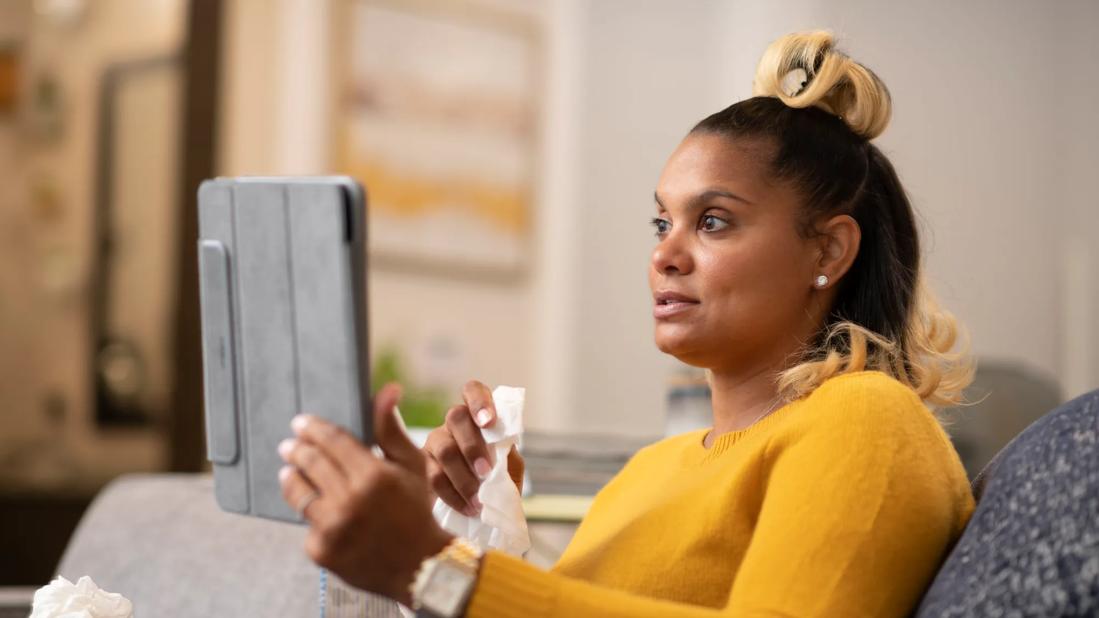New skills are required for conveying empathy via video chat

Three months ago, only about 2% of Cleveland Clinic patient visits were done virtually, by video chat. But then the COVID-19 pandemic hit, and virtual visits shot up to 75%.
Advertisement
Cleveland Clinic is a non-profit academic medical center. Advertising on our site helps support our mission. We do not endorse non-Cleveland Clinic products or services. Policy
While in-office visits will resume as physical distancing restrictions ease, virtual visits are here to stay, says Amy Merlino, MD, Chief Medical Information Officer at Cleveland Clinic.
“I don’t know that we will continue at 75%, but somewhere between 50% and 70% is likely for ambulatory care,” she says.
In addition to quickly adapting to new telehealth privileges, platforms, documentation and workflows, clinicians have needed to learn new ways of communicating with patients during virtual visits.
“Not being in the same room with the patient changes how we connect with them and relate to them,” says Dr. Merlino. “We can’t show empathy by touching them, for example. We need to learn new ways of reassuring patients that we hear them and care for them.”
In response, Cleveland Clinic’s Center for Excellence in Healthcare Communication led the charge in establishing guidelines for digital health communication:
Both documents were released in April as part of Cleveland Clinic’s Digital Health Playbook.
“One of the biggest challenges for clinicians is their initial uncertainty and discomfort with using virtual technology for patient care,” says clinical psychologist Amy Windover, PhD, Director of Communication Skills Training in the Office of Patient Experience at Cleveland Clinic. “It’s new to everybody. Clinicians are desperate for guidance because there is a steep learning curve without some basic training.”
Advertisement
As reflected in the new guidelines, clinicians need to be more intentional about establishing and developing patient relationships during virtual visits, notes Dr. Windover.
“Given the novelty of virtual visits, there’s a risk that clinicians will skip the formalities and try to get right to the point of the visit,” she says. “But that’s like hosting a dinner party where you don’t welcome your guests or hang up their coats, but rather hurry them to your dining room, start passing the dishes and then rush them out the door.”
Taking time to connect with the patient and convey value and respect is especially important when you’re not physically with them. Dr. Windover recommends these simple techniques:
During in-person visits, clinicians may rely on nonverbal cues — like nodding, leaning forward or raising eyebrows — to show empathy. During virtual visits, nonverbal cues may not be as effective due to audio or visual lag time.
“Verbally addressing a patient’s feelings is important in person, but even more important virtually,” says Dr. Windover. “Patients need to hear healthcare providers say that they care about and respect them. Only then will patients trust us enough to share complete information about their symptoms or experiences. And that is vital for us to accurately diagnose and treat their condition.”
Advertisement
For example, empathic statements include:
“There’s a lot of research that says physical touch is helpful in connecting with patients,” says Dr. Windover. “But we can still convey that without physical contact. Putting your hand over your heart, for example, or touching your own arm like you’d touch a patient’s arm are effective ways of showing empathy visually.”
Just be sure to make nonverbal cues like these larger and slower than you would in person, she says, making them more prominent on camera.
Developing a relationship with a patient actually may be easier via virtual visit, notes Dr. Windover. Observing patients in their regular environment — with kids popping in unexpectedly or a collection of books in the background — can help clinicians forge a more immediate and personal connection.
“Watching the family interact or seeing that the patient is still in their pajamas is valuable,” says Dr. Windover. “You can get priceless information instantaneously through virtual visits.”
Advertisement
Advertisement

Patients report improved sense of smell and taste

Clinicians who are accustomed to uncertainty can do well by patients

Unique skin changes can occur after infection or vaccine

Cleveland Clinic analysis suggests that obtaining care for the virus might reveal a previously undiagnosed condition

As the pandemic evolves, rheumatologists must continue to be mindful of most vulnerable patients

Early results suggest positive outcomes from COVID-19 PrEP treatment

Could the virus have caused the condition or triggered previously undiagnosed disease?

Five categories of cutaneous abnormalities are associated with COVID-19